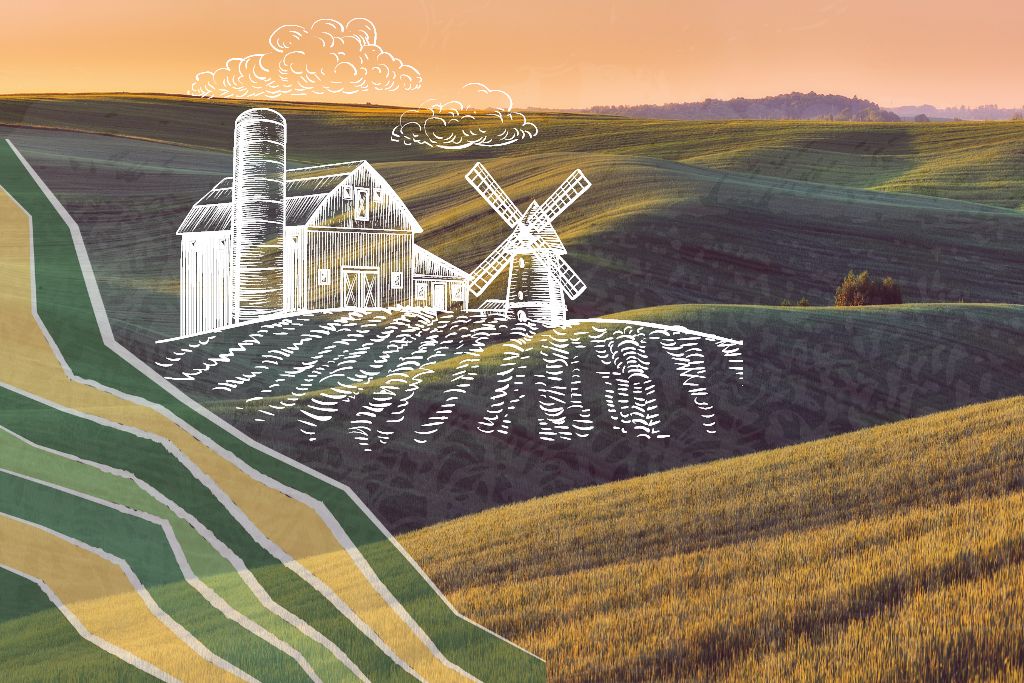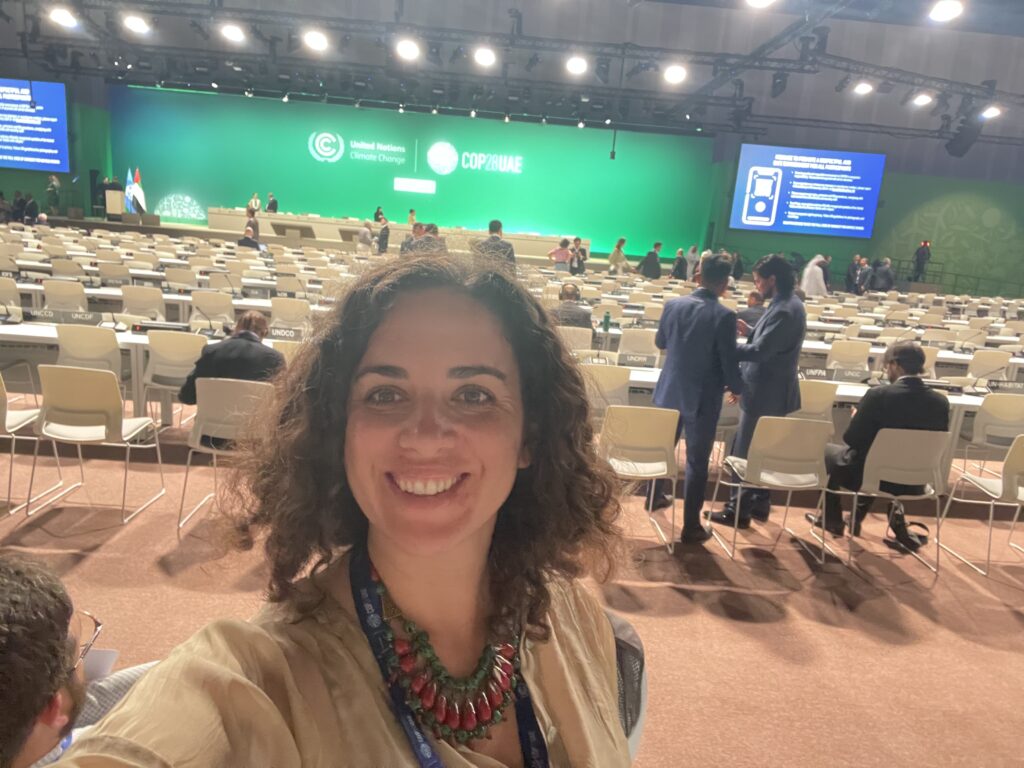Food and Farming Makes the Menu at UN Climate Talks
Guest contributor Antonia Moure Richard of UCLA Law reports that regenerative agriculture was a big focus of COP28, but industrial farming was largely ignored.

At the United Nations climate conference known as COP28, it was easy to come to the realization that we must confront every aspect of the climate crisis, and we must do it right now. That includes transforming our food systems.
Agriculture has historically been left out of the conversation at COP. That changed this year with the Declaration on Sustainable Agriculture, Resilient Food Systems, and Climate Action, which was signed by 134 world leaders. This agreement emphasizes the imperative to adapt agricultural practices to a warming world. COP28 has played host to at least 50 events dedicated to food and agriculture. The conference featured an entire day dedicated to food on December 10. That’s when the UN’s Food and Agriculture Organization provided a “roadmap” for countries to meet their climate targets through “agrifood solutions.”
Being on the ground in Dubai this year as part of the UCLA Emmett Institute delegation, I attended multiple talks geared toward agriculture. I saw the topic of food and climate being addressed in 3 main ways: reducing methane emissions, mainly from waste and cows; improving food security, especially in central African countries; and regenerative agriculture with a focus on small farmers. Missing in action, I thought, was a frank discussion of the impact of industrial farming, the role of carbon sequestration, and agriculture’s potential to transition from being an emitter of greenhouse gases to being a mitigator. Even though most of the food served to attendees at COP was vegan, a broad conversation about meat production and about changing to a plant-based diet was also absent.
Soil: An Opportunity to Do Things Right
Regarding the actual production of food, COP28 offered a notable emphasis on small farms, possibly because of their heightened vulnerability to climate change, requiring immediate adaptation measures. Here, I will focus on soil, particularly on regenerative practices that many small farms have adopted worldwide over time and have become part of the solution.
Since the Industrial Revolution, the most pressing food challenge has been producing enough food for an increasingly industrialized society. The task of producing enough safe, nutritious, and environmentally sustainable food remains unresolved.
Farming, from farm to table, contributes 25% of worldwide greenhouse emissions. That puts it on par with the industrial and power sectors. In the U.S., agriculture takes up almost one billion acres—two-thirds of the contiguous United States—and contributes 30% of greenhouse gas emissions, according to Peter Lehner at Earthjustice. Half of that is for growing food for people to eat, and the other half goes to growing food for animals to eat, according to Lehner. While all that might sound scary, it is, in fact, an opportunity to implement regenerative agriculture practices that can sequester carbon without polluting nearby communities.
One of the problems is that regenerative agriculture is a trendy topic that has been applied more widely than warranted (especially by big companies that are hoping to get in on the trend. Right now, many people claim to be regenerative farming with questionable practices. A working definition by NRDC: “as a philosophy and approach to land management, regenerative agriculture asks us to think about how all aspects of agriculture are connected through a web—a network of entities who grow, enhance, exchange, distribute, and consume goods and services—instead of a linear supply chain. It’s about farming and ranching in a style that nourishes people and the earth, with specific practices varying from grower to grower and from region to region. There’s no strict rule book, but the holistic principles behind the dynamic system of regenerative agriculture are meant to restore soil and ecosystem health, address inequity, and leave our land, waters, and climate in better shape for future generations.”

Some farming collectives are doing it successfully. This can include investments in solar panels for irrigation systems, establishing compost production, and restoring soil health. Successful examples like Fundo Santa Carmen in Chile address skepticism about transitioning to a new model within the farming industry. In this case, they are using a completely organic approach, using sheep to cut the grass and recover soil health. These models are designed to generate the most inputs, minimize costs, offset potential losses, and maintain competitiveness and profitability.
Elevating the priority of reevaluating our dietary choices and production methods is vital. Focusing on cultivating healthy soil can fortify farms, enhancing their resilience to retain water and ensuring genuine food security independent of external inputs. Emphasizing the significance of adapting agriculture is crucial; however, it must be done in a manner that does not exacerbate the very problems it seeks to address. As the adage said, “When you find yourself stuck in a hole, stop digging.” This challenges us to think of creative solutions that address the emissions and the health of the people living on the farms and their communities.
Where is Big Ag in All of This?
One of the main challenges of addressing food systems is that few solutions are one-size-fits-all. Sizeable industrial farming systems operate on a fundamentally different logic than small farmers. There is a big difference in their business model and ability and motivation to invest in change. The local climate and weather patterns, the access to resources, the dietary culture, and the countries’ economies tied to farming make agriculture regionally specific, and hardly one size fits all.
Then, there is the separate but related issue of financing more sustainable, climate-friendly agriculture. As this farmer develops a business model that differs from traditional industrial farming, the financial sector lacks an understanding of how to assess risk accurately, leaving out the resilience of these farms on the equation and seeming to be riskier.
One solution being used right now is a with non-governmental organizations or businesses that frontload costs and facilitate entry into the carbon offset market. Although this approach incurs initial high costs, it promises substantial profitability.
Alternatively, taxpayer subsidies provide another avenue. Investing in policies that actively contribute to solutions and align with sustainability and communal well-being is crucial. By subsidizing such practices, governments can foster genuine food security independent of industrial inputs. Taxpayer funds would support the learning curve of farmers, address contamination issues, and yield resilient agriculture capable of adapting, retaining water, and producing clean, healthy products. In the context of climate change, reimagining an industry that serves society better becomes imperative, requiring the allocation of tax funds to develop sustainable agricultural practices.
Some critics argue against regenerative practices, citing lower productivity of these farms and the increased amount of farmland they can require, which could lead to deforestation, a driver of climate change. However, the problem seems a little more complicated: a significant portion of food ends up in landfills, while the pursuit of more land is often driven by speculation, investment and soil degradation rather than hunger. I wonder how much of the land declared as a farm has actually been used to produce food.
It is crucial to broaden the discourse to encompass the multifaceted impacts of agricultural practices. The implications on soil health, biodiversity, water conservation, pollution and toxins, labor conditions, deforestation, waste management, and public health are significant considerations when addressing the pivotal question of how to feed the world sustainably. Understanding the intricate relationship between agricultural practices and these various facets is paramount in developing comprehensive strategies. Shifting the narrative from focusing solely on adaptation to also including mitigation is essential for crafting a more sustainable and resilient agricultural model.
In the end, COP28 may lay the groundwork for transformative policies that secure food production and foster environmental regeneration, social equity, and improved public health. Much more needs to be done and those ingredients to food policy that were left out at COP28 also need to be added to the menu of the next UN climate talks. In a world where highly processed food dominates diets, deciding what goes on one’s plate has become more political than ever.
Antonia Moure Richard is an LL.M candidate at UCLA Law from Chile.
Reader Comments
2 Replies to “Food and Farming Makes the Menu at UN Climate Talks”
Comments are closed.







This is germane to this article …
Published Nov, 2023 … peer-reviewed …
https://www.nature.com/articles/s41467-023-43452-3
From Abstract:
<>
From Text:
<>
This is germane to this article …
Published Nov, 2023 … peer-reviewed …
https://www.nature.com/articles/s41467-023-43452-3
From Abstract:
<>